fuel pressure MERCEDES-BENZ C240 2002 W203 Owner's Manual
[x] Cancel search | Manufacturer: MERCEDES-BENZ, Model Year: 2002, Model line: C240, Model: MERCEDES-BENZ C240 2002 W203Pages: 406
Page 8 of 406

5 ContentsSEAT BELT SYSTEM ...................299
ELEC. STABIL. PROG.
(Electronic stability program) ..300
COOLANT
(coolant level) ............................. 301
COOLANT
(coolant temperature) ................302
ENGINE OIL LEVEL ...................303
LIGHTING SYSTEM ....................304
LAMP SENSOR ...........................306
DOOR ............................................306
TRUNK OPEN .............................307
HOOD ...........................................307
TELEPHONE – FUNCTION .......308
TELE AID .....................................308
WASHER FLUID ..........................309
RESTRAINT SYSTEM ................. 310
KEY ............................................... 310
FUEL RESERVE .......................... 311
UNDERVOLTAGE ........................ 311
STEER. WHEEL ADJUST. ........... 312
Practical hintsFirst aid kit ...................................... 314
Stowing things in the vehicle ....... 314
Fuses ................................................ 315
Hood ................................................. 318
Adding engine oil .......................... 321
Automatic transmission
fluid level ................................... 322
Coolant level ................................... 322
Adding coolant ........................... 323
Windshield and
headlamp washer system ........ 323
Spare wheel, vehicle tools,
storage compartment ............... 325
TIREFIT, vehicle tools,
storage compartment
(C 32 AMG only) ....................... 326
Vehicle jack .................................... 327
Wheels ............................................ 328
Tire replacement ....................... 328
Rotating wheels ......................... 329Spare wheel ....................................330
Spare wheel bolts .......................330
Changing wheels ........................... 331
TIREFIT ...........................................337
Tire inflation pressure .................. 341
Battery .............................................342
Jump starting ..................................344
Towing the vehicle .........................347
Transmission selector lever,
manually unlocking ...................350
Exterior lamps ................................ 351
Replacing bulbs .......................... 351
Standby bulb function ...................356
Changing batteries in the
electronic main key ..................357
Synchronizing
remote control ............................359
Emergency engine shut-down .....359
Fuel filler flap, manual release ...360
Replacing wiper blade insert .......362
Roof rack .........................................363
OM_203.book Seite 5 Donnerstag, 31. Mai 2001 11:57 11
Page 264 of 406
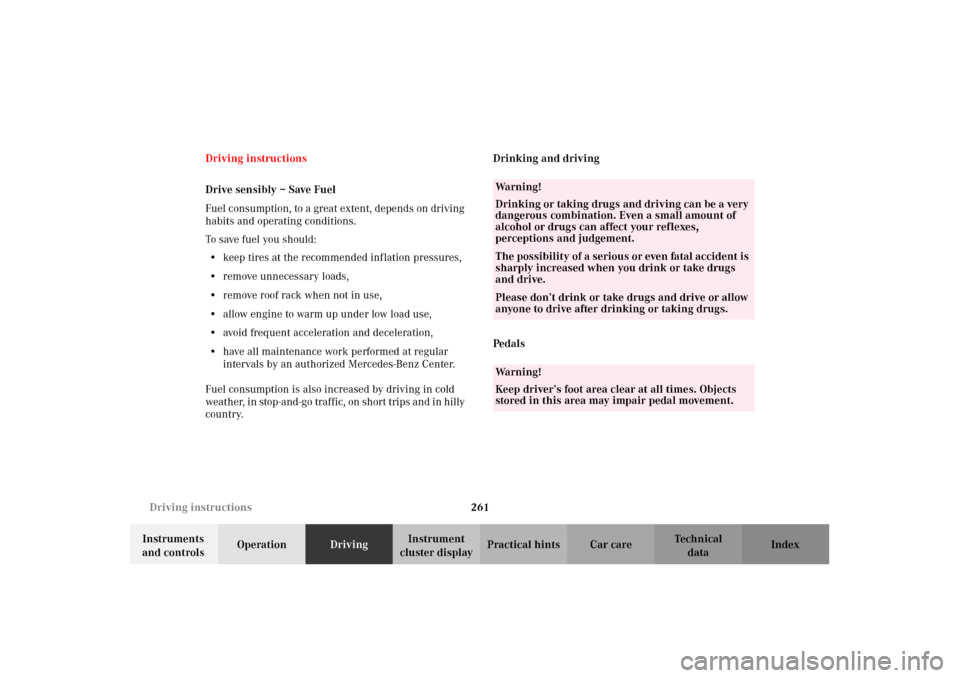
261 Driving instructions
Te ch n i c a l
data Instruments
and controlsOperationDrivingInstrument
cluster displayPractical hints Car care Index Driving instructions
Drive sensibly – Save Fuel
Fuel consumption, to a great extent, depends on driving
habits and operating conditions.
To save fuel you should:
•keep tires at the recommended inflation pressures,
•remove unnecessary loads,
•remove roof rack when not in use,
•allow engine to warm up under low load use,
•avoid frequent acceleration and deceleration,
•have all maintenance work performed at regular
intervals by an authorized Mercedes-Benz Center.
Fuel consumption is also increased by driving in cold
weat her, i n stop -and -go traf f ic, on short trip s an d i n hilly
country.Drinking and driving
Ped al s
Wa r n i n g !
Drinking or taking drugs and driving can be a very
dangerous combination. Even a small amount of
alcohol or drugs can affect your reflexes,
perceptions and judgement.The possibility of a serious or even fatal accident is
sharply increased when you drink or take drugs
and drive.Please don’t drink or take drugs and drive or allow
anyone to drive after drinking or taking drugs.Wa r n i n g !
Keep driver’s foot area clear at all times. Objects
stored in this area may impair pedal movement.
OM_203.book Seite 261 Donnerstag, 31. Mai 2001 11:57 11
Page 285 of 406
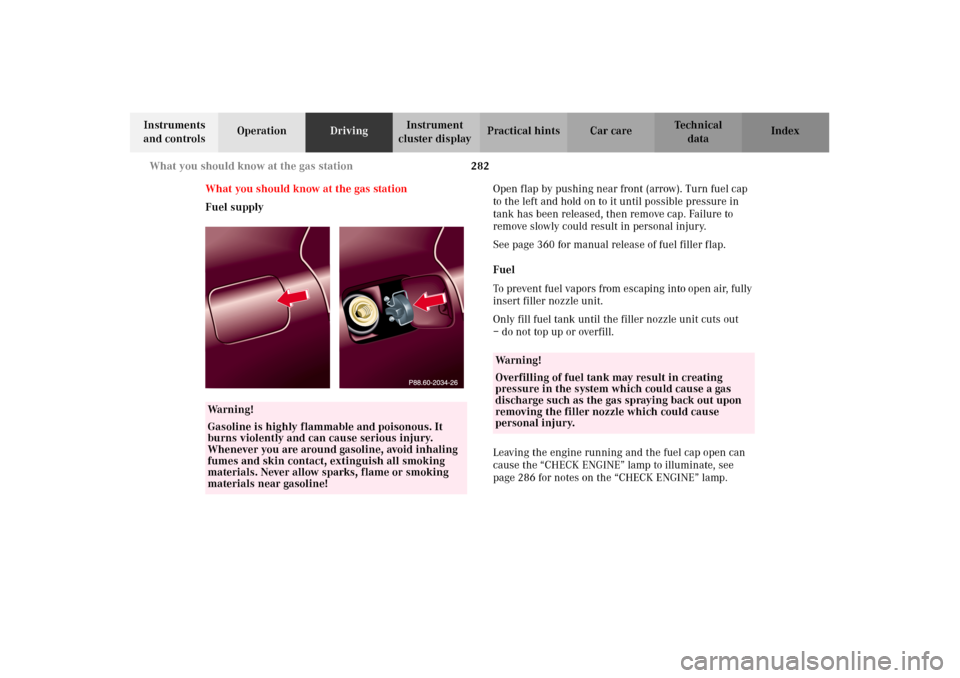
282 What you should know at the gas station
Te ch n i c a l
data Instruments
and controlsOperationDrivingInstrument
cluster displayPractical hints Car care Index
What you should know at the gas station
Fuel supplyOpen flap by pushing near front (arrow). Turn fuel cap
to the left and hold on to it until possible pressure in
tank has been released, then remove cap. Failure to
remove slowly could result in personal injury.
See page 360 for manual release of fuel filler flap.
Fuel
To prevent fuel vapors from escaping into open air, fully
insert filler nozzle unit.
Only fill fuel tank until the filler nozzle unit cuts out
– do not top up or overfill.
Leaving the engine running and the fuel cap open can
cause the “CHECK ENGINE” lamp to illuminate, see
page 286 for notes on the “CHECK ENGINE” lamp.
Wa r n i n g !
Gasoline is highly flammable and poisonous. It
burns violently and can cause serious injury.
Whenever you are around gasoline, avoid inhaling
fumes and skin contact, extinguish all smoking
materials. Never allow sparks, flame or smoking
materials near gasoline!
Wa r n i n g !
Overfilling of fuel tank may result in creating
pressure in the system which could cause a gas
discharge such as the gas spraying back out upon
removing the filler nozzle which could cause
personal injury.
OM_203.book Seite 282 Donnerstag, 31. Mai 2001 11:57 11
Page 286 of 406
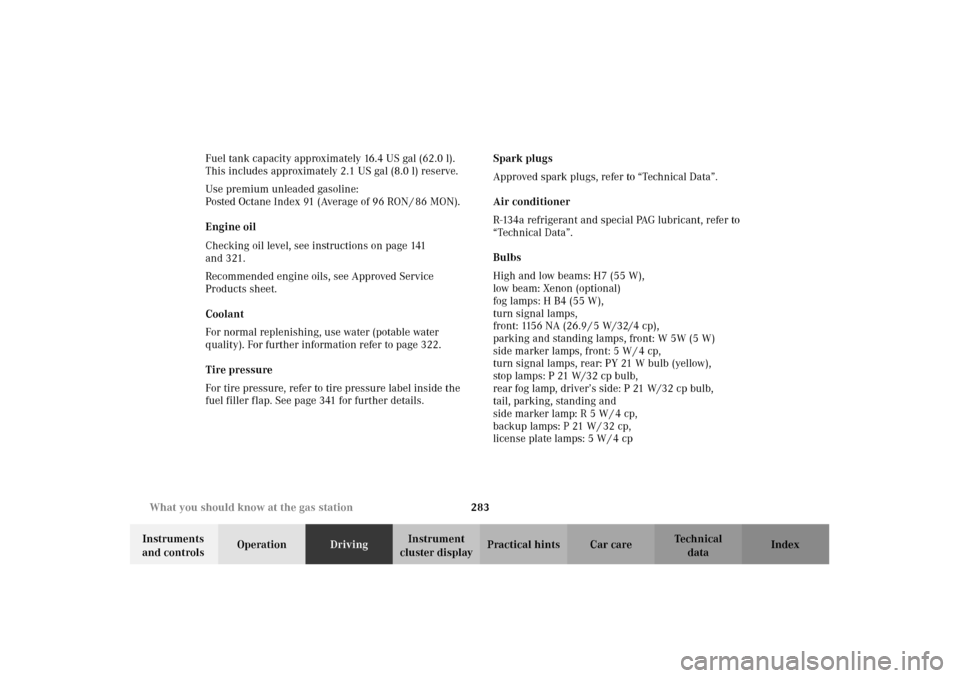
283 What you should know at the gas station
Te ch n i c a l
data Instruments
and controlsOperationDrivingInstrument
cluster displayPractical hints Car care Index Fuel tank capacity approximately 16.4 US gal (62.0 l).
This includes approximately 2.1 US gal (8.0 l) reserve.
Use premium unleaded gasoline:
Posted Octane Index 91 (Average of 96 RON / 86 MON).
Engine oil
Checking oil level, see instructions on page 141
and 321.
Recommended engine oils, see Approved Service
Products sheet.
Coolant
For normal replenishing, use water (potable water
quality). For further information refer to page 322.
Tire pressure
For tire pressure, refer to tire pressure label inside the
fuel filler flap. See page 341 for further details.Spark plugs
Approved spark plugs, refer to “Technical Data”.
Air conditioner
R-134a refrigerant and special PAG lubricant, refer to
“Technical Data”.
Bulbs
High and low beams: H7 (55 W),
low beam: Xenon (optional)
fog lamps: H B4 (55 W),
turn signal lamps,
front: 1156 NA (26.9 / 5 W/32/4 cp),
parking and standing lamps, front: W 5W (5 W)
side marker lamps, front: 5 W / 4 cp,
turn signal lamps, rear: PY 21 W bulb (yellow),
stop lamps: P 21 W/32 cp bulb,
rear fog lamp, driver’s side: P 21 W/32 cp bulb,
tail, parking, standing and
side marker lamp: R 5 W / 4 cp,
backup lamps: P 21 W / 32 cp,
license plate lamps: 5 W / 4 cp
OM_203.book Seite 283 Donnerstag, 31. Mai 2001 11:57 11
Page 316 of 406

313 Contents - Practical hints
Te ch n i c a l
data Instruments
and controlsOperation DrivingInstrument
cluster displayPractical hintsCar care Index
Practical hintsFirst aid kit ..................................... 314
Stowing things in the vehicle ...... 314
Fuses ................................................ 315
Hood ................................................. 318
Adding engine oil .......................... 321
Automatic transmission
fluid level ...................................322
Coolant level ...................................322
Adding coolant ...........................323
Windshield and
headlamp washer system ........323
Spare wheel, vehicle tools,
storage compartment ................325TIREFIT, vehicle tools,
storage compartment
(C 32 AMG only) ....................... 326
Vehicle jack .................................... 327
Wheels ............................................ 328
Tire replacement ....................... 328
Rotating wheels ......................... 329
Spare wheel .................................... 330
Spare wheel bolts ...................... 330
Changing wheels ........................... 331
TIREFIT ........................................... 337
Tire inflation pressure ................. 341
Battery ............................................. 342
Jump starting ................................. 344Towing the vehicle .........................347
Transmission selector lever,
manually unlocking ...................350
Exterior lamps ................................ 351
Replacing bulbs .......................... 351
Standby bulb function ...................356
Changing batteries in the
electronic main key ..................357
Synchronizing
remote control ............................359
Emergency engine shut-down .....359
Fuel filler flap, manual release ...360
Replacing wiper blade insert .......362
Roof rack .........................................363
OM_203.book Seite 313 Donnerstag, 31. Mai 2001 11:57 11
Page 332 of 406
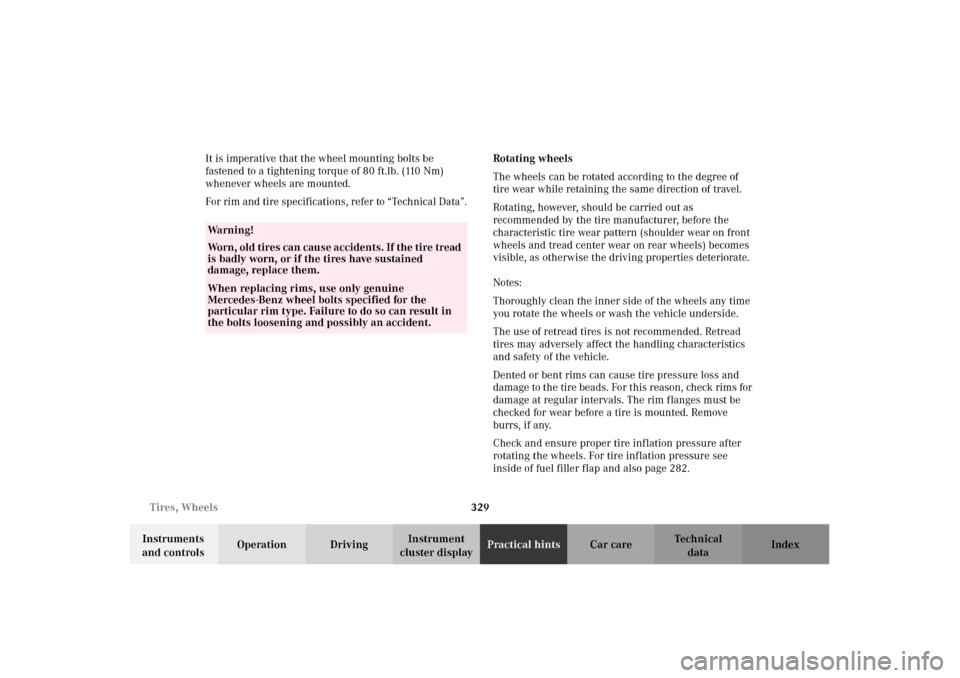
329 Tires, Wheels
Te ch n i c a l
data Instruments
and controlsOperation DrivingInstrument
cluster displayPractical hintsCar care Index It is imperative that the wheel mounting bolts be
fastened to a tightening torque of 80 ft.lb. (110 Nm)
whenever wheels are mounted.
For rim and tire specifications, refer to “Technical Data”.Rotating wheels
The wheels can be rotated according to the degree of
tire wear while retaining the same direction of travel.
Rotating, however, should be carried out as
recommended by the tire manufacturer, before the
characteristic tire wear pattern (shoulder wear on front
wheels and tread center wear on rear wheels) becomes
visible, as otherwise the driving properties deteriorate.
Notes:
Thoroughly clean the inner side of the wheels any time
you rotate the wheels or wash the vehicle underside.
The use of retread tires is not recommended. Retread
tires may adversely affect the handling characteristics
and safety of the vehicle.
Dented or bent rims can cause tire pressure loss and
damage to the tire beads. For this reason, check rims for
damage at regular intervals. The rim flanges must be
checked for wear before a tire is mounted. Remove
burrs, if any.
Check and ensure proper tire inflation pressure after
rotating the wheels. For tire inflation pressure see
inside of fuel filler flap and also page 282.
Wa r n i n g !
Worn, old tires can cause accidents. If the tire tread
is badly worn, or if the tires have sustained
damage, replace them.When replacing rims, use only genuine
Mercedes-Benz wheel bolts specified for the
particular rim type. Failure to do so can result in
the bolts loosening and possibly an accident.
OM_203.book Seite 329 Donnerstag, 31. Mai 2001 11:57 11
Page 344 of 406
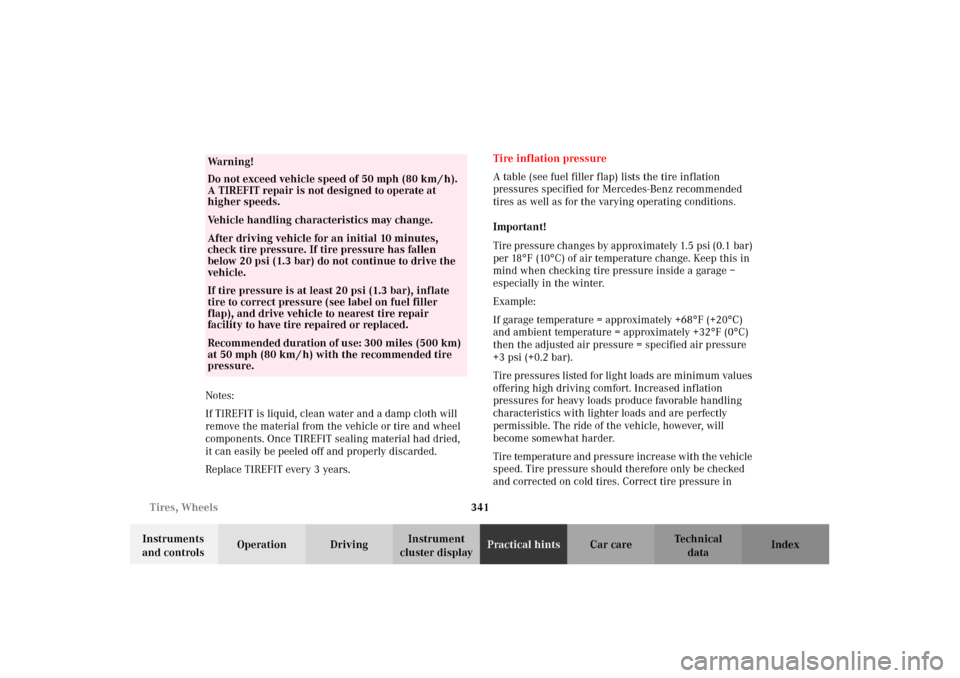
341 Tires, Wheels
Te ch n i c a l
data Instruments
and controlsOperation DrivingInstrument
cluster displayPractical hintsCar care Index Notes:
If TIREFIT is liquid, clean water and a damp cloth will
remove the material from the vehicle or tire and wheel
components. Once TIREFIT sealing material had dried,
it can easily be peeled off and properly discarded.
Replace TIREFIT every 3 years.Tire inflation pressure
A table (see fuel filler flap) lists the tire inflation
pressures specified for Mercedes-Benz recommended
tires as well as for the varying operating conditions.
Important!
Tire pressure changes by approximately 1.5 psi (0.1 bar)
per 18
°F (10
°C) of air temperature change. Keep this in
mind when checking tire pressure inside a garage –
especially in the winter.
Example:
If garage temperature = approximately +68
°F (+20
°C)
and ambient temperature = approximately +32
°F (0
°C)
then the adjusted air pressure = specified air pressure
+3 psi (+0.2 bar).
Tire pressures listed for light loads are minimum values
offering high driving comfort. Increased inflation
pressures for heavy loads produce favorable handling
characteristics with lighter loads and are perfectly
permissible. The ride of the vehicle, however, will
become somewhat harder.
Tire temperature and pressure increase with the vehicle
speed. Tire pressure should therefore only be checked
and corrected on cold tires. Correct tire pressure in
Wa r n i n g !
Do not exceed vehicle speed of 50 mph (80 km / h).
A TIREFIT repair is not designed to operate at
higher speeds.Vehicle handling characteristics may change.After driving vehicle for an initial 10 minutes,
check tire pressure. If tire pressure has fallen
below 20 psi (1.3 bar) do not continue to drive the
vehicle.If tire pressure is at least 20 psi (1.3 bar), inflate
tire to correct pressure (see label on fuel filler
flap), and drive vehicle to nearest tire repair
facility to have tire repaired or replaced.Recommended duration of use: 300 miles (500 km)
at 50 mph (80 km / h) with the recommended tire
pressure.
OM_203.book Seite 341 Donnerstag, 31. Mai 2001 11:57 11
Page 387 of 406

384 Fuels, coolants, lubricants etc. - capacities
Te ch n i c a l
data Instruments
and controlsOperation DrivingInstrument
cluster displayPractical hints Car care Index
Premium unleaded gasoline
Caution!
To maintain the engine’s durability and performance,
premium unleaded gasoline must be used. If premium
unleaded is not available and low octane fuel is used,
follow these precautions:
•have the fuel tank filled only partially with unleaded
regular and fill up with premium unleaded as soon
as possible,
•avoid full throttle driving and abrupt acceleration,
•do not exceed an engine speed of 3000 rpm, if the
vehicle is loaded with a light load such as two
persons and no luggage,
•do not exceed
2/3 of maximum accelerator pedal
position, if the vehicle is fully loaded or operating in
mountainous terrain.Fuel requirements
Use only Premium unleaded meeting ASTM
standard D 439:
The octane number (posted at the pump) must be
91 min. It is an average of both the Research (R) octane
number and the Motor (M) octane number: (R+M) / 2).
This is also known as ANTI-KNOCK INDEX.
Unleaded gasoline containing oxygenates such as
Ethanol, IPA, IBA and TBA can be used provided the
ratio of any one of these oxygenates to gasoline does not
exceed 10%, MTBE not to exceed 15%.
The ratio of Methanol to gasoline must not exceed 3%
plus additional cosolvents.
Using mixtures of Ethanol and Methanol is not allowed.
Gasohol, which contains 10% Ethanol and 90% unleaded
gasoline, can be used.
These blends must also meet all other fuel requirements
such as resistance to spark knock, boiling range, vapor
pressure etc.
OM_203.book Seite 384 Donnerstag, 31. Mai 2001 11:57 11